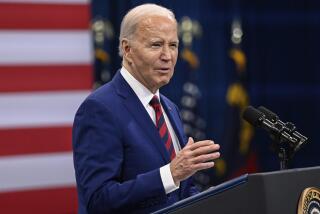Rand poll tries something different, gets same results: Obama leading
Take 10 presidential campaign polls and you’ll probably find 10 slightly different results. Part of that is sampling error --the random luck of who is answering the poll. Part of it is methodology: How are people chosen, what questions are asked, how are the results weighted to conform to what is known of the political landscape?
For the most part, though, the idea is the same: Call a bunch of voters at random and ask them questions over the phone.
The Rand Corp. is trying something quite different this year. And part of what’s interesting is that the results are pretty much the same as everybody else’s.
Rand’s 2012 Presidential Election Poll involves a single panel of voters who are asked the same three questions over and over. Since July 11, each of its 3,500 participants has answered the questions on a weekly basis -- but staggered so that one-seventh of the results come in every day. They answer the questions online, and those who didn’t have Internet access before the poll are given computers to use.
The results have been more or less in line with those of other major polls. Former Massachusetts Gov. Mitt Romney and President Obama were running neck and neck -- until Sept. 7, the day after former President Clinton spoke at the Democratic National Convention. Ever since then, Obama has been rising and Romney falling in the poll.
“If you look at where we are and where we started, it seems to be pretty consistent with what you see in every other poll,” said Arie Kapteyn, a senior economist at Rand’s Santa Monica office who directs the poll. “It doesn’t really deviate.”
The latest results, for Friday, show Obama at 50.3% and Romney at 43.2%, a 7-point spread that is well beyond the poll’s margin of error (which changes every day, but basically covers a band of about 4 percentage points). That is a hair’s breadth away from the latest Gallup tracking poll, which shows Obama at 50% and Romney at 44%.
Kapteyn conceded that the poll’s questions make it impossible to know why some voters are changing their minds. He said he hopes to do in-depth follow-up after the election to find out what was going through people’s minds as they made their choices.
INTERACTIVE: Battleground states, predict a winner
The questions themselves are unusual. Rather than simply being asked whom they support, the respondents are asked these three questions:
- What is the percent chance that you will vote in the Presidential election?
- What is the percent chance that you will vote for Obama, Romney, someone else?
- What is the percent chance that Obama, Romney [or] someone else will win?
The Rand poll relies on its American Life Panel, a group of poll respondents who have agreed to answer online questions on a variety of topics. For instance, the panel has been surveyed since November 2008 about the economy and how individuals have been weathering the recession. Members are paid a token fee to participate.
Gary Langer, the president of Langer Research Associates, an independent polling firm, said such surveys are valuable for longitudinal research such as Rand’s recession study, but he questioned the value of the poll in a presidential race. He said there is a risk that people who answer the same question over time may begin to adjust their behavior and their thinking in response to the poll -- what he called “the training wheel effect.”
In a nod to George Stephanopoulos, the political correspondent at ABC News (where Langer formerly worked), he said: “If these people know that it is now their job … to be attuned to politics and express opinions about it on an ongoing basis, you’ve in effect created a flock of Stephanopouli … and you’re not anymore measuring the attitudes of a sampling of the general population.”
INTERACTIVE: Outside spending shapes election
Langer was also scornful of the questions being asked in the survey. “People don’t walk around thinking in percentages,” he said. “I think a lot of respondents would be challenged cognitively to answer those questions in a meaningful way.”
Kapteyn was modest in his own assessment of the poll. “We’re not really claiming that this is better than anything else,” he said. “We think it’s a nice addition.”
And, as every trailing candidate will tell you, the only poll that counts is the one on election day.
Follow Politics Now on Twitter and Facebook
mitchell.landsberg@latimes.com
Twitter: LATlands
More to Read
Get the L.A. Times Politics newsletter
Deeply reported insights into legislation, politics and policy from Sacramento, Washington and beyond. In your inbox three times per week.
You may occasionally receive promotional content from the Los Angeles Times.






